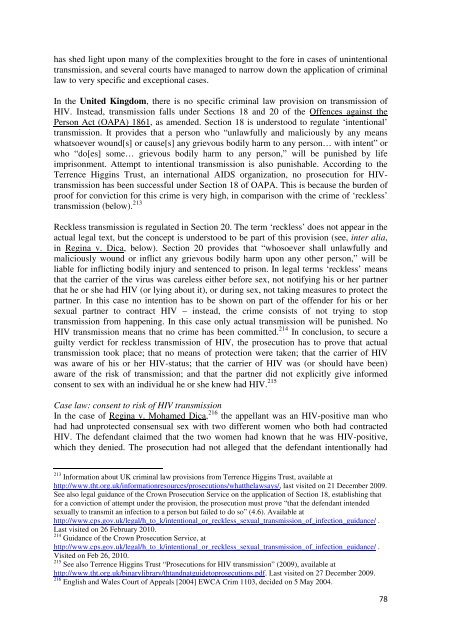Johanna Westeson - The ICHRP
Johanna Westeson - The ICHRP
Johanna Westeson - The ICHRP
Create successful ePaper yourself
Turn your PDF publications into a flip-book with our unique Google optimized e-Paper software.
has shed light upon many of the complexities brought to the fore in cases of unintentional<br />
transmission, and several courts have managed to narrow down the application of criminal<br />
law to very specific and exceptional cases.<br />
In the United Kingdom, there is no specific criminal law provision on transmission of<br />
HIV. Instead, transmission falls under Sections 18 and 20 of the Offences against the<br />
Person Act (OAPA) 1861, as amended. Section 18 is understood to regulate ‘intentional’<br />
transmission. It provides that a person who “unlawfully and maliciously by any means<br />
whatsoever wound[s] or cause[s] any grievous bodily harm to any person… with intent” or<br />
who “do[es] some… grievous bodily harm to any person,” will be punished by life<br />
imprisonment. Attempt to intentional transmission is also punishable. According to the<br />
Terrence Higgins Trust, an international AIDS organization, no prosecution for HIVtransmission<br />
has been successful under Section 18 of OAPA. This is because the burden of<br />
proof for conviction for this crime is very high, in comparison with the crime of ‘reckless’<br />
transmission (below). 213<br />
Reckless transmission is regulated in Section 20. <strong>The</strong> term ‘reckless’ does not appear in the<br />
actual legal text, but the concept is understood to be part of this provision (see, inter alia,<br />
in Regina v. Dica, below). Section 20 provides that “whosoever shall unlawfully and<br />
maliciously wound or inflict any grievous bodily harm upon any other person,” will be<br />
liable for inflicting bodily injury and sentenced to prison. In legal terms ‘reckless’ means<br />
that the carrier of the virus was careless either before sex, not notifying his or her partner<br />
that he or she had HIV (or lying about it), or during sex, not taking measures to protect the<br />
partner. In this case no intention has to be shown on part of the offender for his or her<br />
sexual partner to contract HIV – instead, the crime consists of not trying to stop<br />
transmission from happening. In this case only actual transmission will be punished. No<br />
HIV transmission means that no crime has been committed. 214 In conclusion, to secure a<br />
guilty verdict for reckless transmission of HIV, the prosecution has to prove that actual<br />
transmission took place; that no means of protection were taken; that the carrier of HIV<br />
was aware of his or her HIV-status; that the carrier of HIV was (or should have been)<br />
aware of the risk of transmission; and that the partner did not explicitly give informed<br />
consent to sex with an individual he or she knew had HIV. 215<br />
Case law: consent to risk of HIV transmission<br />
In the case of Regina v. Mohamed Dica, 216 the appellant was an HIV-positive man who<br />
had had unprotected consensual sex with two different women who both had contracted<br />
HIV. <strong>The</strong> defendant claimed that the two women had known that he was HIV-positive,<br />
which they denied. <strong>The</strong> prosecution had not alleged that the defendant intentionally had<br />
213 Information about UK criminal law provisions from Terrence Higgins Trust, available at<br />
http://www.tht.org.uk/informationresources/prosecutions/whatthelawsays/, last visited on 21 December 2009.<br />
See also legal guidance of the Crown Prosecution Service on the application of Section 18, establishing that<br />
for a conviction of attempt under the provision, the prosecution must prove “that the defendant intended<br />
sexually to transmit an infection to a person but failed to do so” (4.6). Available at<br />
http://www.cps.gov.uk/legal/h_to_k/intentional_or_reckless_sexual_transmission_of_infection_guidance/ .<br />
Last visited on 26 February 2010.<br />
214 Guidance of the Crown Prosecution Service, at<br />
http://www.cps.gov.uk/legal/h_to_k/intentional_or_reckless_sexual_transmission_of_infection_guidance/ .<br />
Visited on Feb 26, 2010.<br />
215 See also Terrence Higgins Trust “Prosecutions for HIV transmission” (2009), available at<br />
http://www.tht.org.uk/binarylibrary/thtandnatguidetoprosecutions.pdf. Last visited on 27 December 2009.<br />
216 English and Wales Court of Appeals [2004] EWCA Crim 1103, decided on 5 May 2004.<br />
78
















